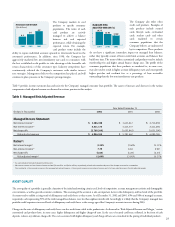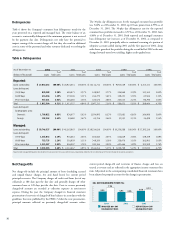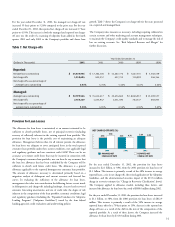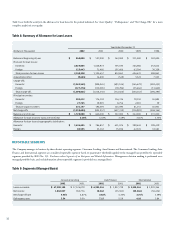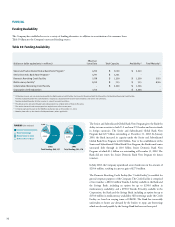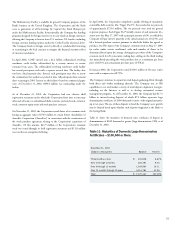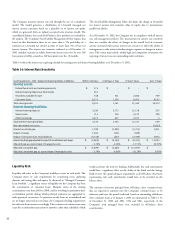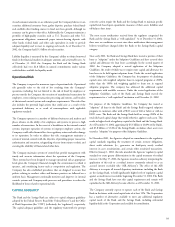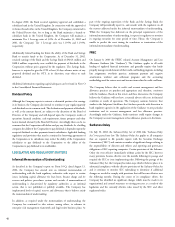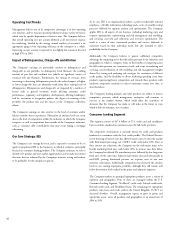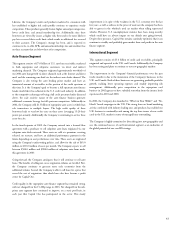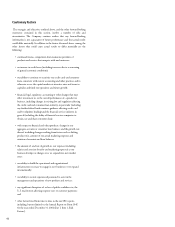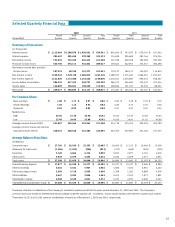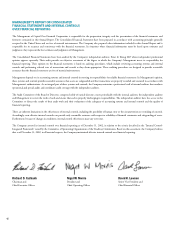Capital One 2002 Annual Report Download - page 39
Download and view the complete annual report
Please find page 39 of the 2002 Capital One annual report below. You can navigate through the pages in the report by either clicking on the pages listed below, or by using the keyword search tool below to find specific information within the annual report.
37
DERIVATIVE INSTRUMENTS
The Company enters into interest rate swap agreements in order to manage
interest rate exposure. In most cases, this exposure is related to the funding of
fixed rate assets with floating rate obligations, including off-balance sheet
securitizations. The Company also enters into forward foreign currency
exchange contracts and cross currency swaps to reduce sensitivity to changing
foreign currency exchange rates. The hedging of foreign currency exchange
rates is limited to certain intercompany obligations related to international
operations. These derivatives expose the Company to certain credit risks. The
Company has established policies and limits, as well as collateral agreements,
to manage credit risk related to derivative instruments.
Additional information regarding derivative instruments can be found in
Note S to the Consolidated Financial Statements.
RISK MANAGEMENT
Risk is an inherent part of the Company’s business and activities. The
Company’s ability to properly and effectively identify, assess, monitor and
manage risk in its business activities is critical to its safe and sound operation
and profitability. The Company’s business activities generate credit risk,
liquidity risk, interest rate risk and operational risk, each of which is
described below.
Credit Risk
Credit risk is one of the Company’s most important risk categories.
Consequently, as part of the Company’s risk management process, stronger
central control of credit policies and programs has been established, while
maintaining the ability of the Company’s operating units to respond flexibly
to changing market and competitive conditions. In 2002, the Company
appointed a dedicated Chief Credit Officer, expanded its central Credit Risk
Management staff and strengthened its Credit Policy Committee. The credit
committee and staff group ensure that the Company’s credit decisions are
made on a conservative basis, that each of its operating units apply best
practices in measuring and managing credit risk, and that all relevant factors,
including credit outlook, profitability, and the competitive, economic and
regulatory environment are considered in making credit decisions.
In addition to strong governance, another key element in the Company’s
management of credit risk is its use of IBS. In its credit policy, the Company
has identified six key principles which govern the use of IBS in credit
management. These principles are: (1) Empirical Evidence - that all decisions
shall be made on the basis of the best available data; (2) Inseparability - that it
is impossible to separate credit decisions from product terms and marketing
channels; (3) Expectation of Volatility - that the expectation that future credit
performance could be worse than past credit performance should be
explicitly factored into underwriting decisions; (4) Positive Net Present Value
- that all prospective and existing pools of accounts need to have a positive
net present value when solicited or when the terms of the loans are adjusted;
(5) Earnings Stability - that a loan shall only be booked if the Company will
be satisfied with the loan’s performance during each discrete period of the
loan’s life; and (6) Constrained Optimization - that individual credit
programs will sometimes be limited to insure that the overall portfolio and
specific individual account characteristics conform to limits established by the
Company and its Board of Directors.
These principles are the foundation of the Company’s credit decision making
approach. They govern the selection of customers, and the approach to
pricing, credit line management, customer management, collections and
recoveries. They provide a framework in which the Company can apply a
very high degree of analytical rigor to decision making while preserving the
flexibility to respond quickly to changing market and economic conditions.
The Company’s credit risk profile is managed to maintain better than average
credit quality, strong risk-adjusted returns and increased diversification. This
is accomplished by increasing growth in the prime and superprime card
business, while reducing growth in the subprime card business, by
customizing credit lines and product terms to each consumer segment to
ensure appropriate returns, by diversification into consumer lending,
products such as automobile financing and unsecured installment lending
and by international expansion. The centralized Credit Risk Management
group monitors overall composition and quality of the credit portfolio. The
Company takes into consideration potential future economic conditions
when monitoring and assessing its credit portfolio to understand its credit
risk profile under various stressful conditions.
The Company’s guiding principles, strengthened central governance and
Board-directed risk tolerances, ensure that senior executives are well-informed
of credit trends and can make appropriate credit and business decisions for the
Company. The Company ensures day-to-day market responsiveness and
flexibility by empowering its business line managers to develop credit strategies
and programs aligned with the objective of long-term business profitability.
The credit program development process considers the evolving needs of the
target market, the competitive environment and the economic outlook. It is
highly analytical and uses the Company’s extensive database of past test results.
Senior Credit Officers, who are appointed by the Credit Policy Committee,
oversee all credit program development. Large new programs or program
changes are reviewed by the Credit Policy Committee or its subcommittee.
Most of the Company’s credit strategies rely heavily on the use of
sophisticated proprietary scoring models. These models consider many
variables, including credit scores developed by nationally recognized scoring
firms. The models are validated, monitored and maintained in accordance
with detailed policies and procedures to ensure their continued validity.
Interest Rate Risk
Interest rate risk refers to changes in earnings or the net present value of assets
and off-balance sheet positions less liabilities (termed “economic value of
equity”) due to interest rate changes. To the extent that managed interest
income and expense do not respond equally to changes in interest rates, or
that all rates do not change uniformly, earnings and economic value of equity
could be affected. The Company’s managed net interest income is affected
primarily by changes in LIBOR, as variable rate card receivables, securitization
bonds and corporate debts are repriced. The Company manages and mitigates
its interest rate sensitivity through several techniques, which include, but are
not limited to, changing the maturity, repricing and distribution of assets and
liabilities and by entering into interest rate swaps.




